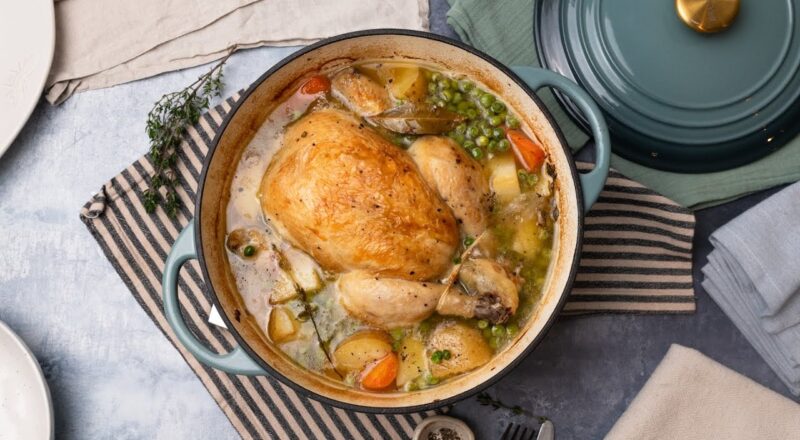Many home cooks and professional chefs often find themselves asking, can you use a cast iron braiser on induction? Understanding the compatibility of your cookware with your cooking range is crucial for achieving the best culinary results. If you own an induction cooktop and are curious about whether your beloved cast iron braiser will work with it, you’ve come to the right place.
An induction stove works differently than traditional gas or electric stoves. It uses electromagnetic fields to heat the cookware directly, which requires the pots and pans to be made of or contain a magnetic material. This brings us to the question: Is a cast iron braiser suitable for induction cooking? Let’s dive deeper into this topic to find out.

Understanding Induction Cooking
Induction cooking is gaining popularity due to its energy efficiency and speed. Unlike traditional stoves that heat the burner, induction cooktops transfer energy directly to the cookware through a magnetic field. This means that the cookware itself becomes the heat source, allowing for quicker heating and precise temperature control.
For induction cooking to work, your cookware must have a magnetic base. This is where cast iron, known for its excellent heat retention and even cooking, comes into play. But does it work with induction? Let’s find out.
Why Cast Iron Braisers are Ideal for Induction
Cast iron braisers are a great choice for induction cooking because they are inherently magnetic. The iron base interacts seamlessly with the magnetic field generated by the induction cooktop. This allows for efficient heat transfer and precise cooking control.
Additionally, cast iron is known for its durability and ability to maintain a consistent temperature, making it ideal for slow-cooked dishes and braising. Its heavy construction ensures even heat distribution, which is a significant advantage when cooking on an induction stove.
Key Features of Cast Iron Braiser
Before using a cast iron braiser on an induction cooktop, it’s essential to understand its key features:
- Material: Made from cast iron, which is naturally magnetic.
- Durability: Known for its long-lasting nature.
- Heat Retention: Excellent for maintaining consistent temperatures.
- Versatility: Suitable for a range of cooking methods, including braising, searing, and baking.
How to Use a Cast Iron Braiser on Induction
Using a cast iron braiser on induction is straightforward. Here are some steps to ensure optimal performance:
1. Ensure Flat Contact
Ensure that the base of the braiser is flat and clean. This ensures maximum contact with the induction cooktop, leading to efficient heating.
2. Preheat Gradually
Cast iron takes time to heat up, so gradually preheat your braiser on low to medium settings. This prevents sudden thermal shock, which could damage the cookware.
3. Use the Right Size
Choose a braiser that matches the size of your induction burner. This ensures even heating and optimal energy efficiency.
Benefits of Using Cast Iron Braiser on Induction
Using a cast iron braiser on an induction cooktop offers numerous advantages:
Energy Efficiency
Induction cooking is known for its energy efficiency, and pairing it with a cast iron braiser further enhances this efficiency. The cookware heats up quickly and retains heat, reducing energy consumption.
Consistent Cooking
The even heat distribution of cast iron ensures consistent cooking results, whether you’re searing meat or making a slow-cooked stew.
Enhanced Flavor
Cast iron braisers are excellent for developing rich flavors in dishes. The even heat and ability to maintain low temperatures allow for perfect browning and caramelization, enhancing the taste of your meals.
Potential Drawbacks
While there are many benefits, there are a few potential drawbacks to consider:
Weight
Cast iron is heavy, which might be challenging for some users to handle, especially when filled with food.
Care and Maintenance
Proper care is essential to maintain the performance of your cast iron braiser. Regular seasoning and cleaning are necessary to keep it in top condition. For more tips, you can check out care tips.
Choosing the Right Cast Iron Braiser
When selecting a cast iron braiser for your induction cooktop, consider the following:
Size and Capacity
Choose a size that suits your cooking needs. Larger braisers are ideal for family meals, while smaller ones are perfect for individual portions.
Quality and Brand
Invest in a high-quality brand known for its durability and performance. Brands like Lodge and Le Creuset are popular choices among chefs and home cooks alike.
Design and Features
Look for features like a tight-fitting lid and sturdy handles for better control and convenience.
Conclusion
The answer to the question, can you use a cast iron braiser on induction?, is a resounding yes. Not only is it compatible, but it also offers numerous benefits, from energy efficiency to enhanced cooking results. By understanding how to use and care for your cast iron braiser, you can enjoy delicious and perfectly cooked meals every time.

FAQs
1. Is all cast iron cookware suitable for induction?
Yes, most cast iron cookware is suitable for induction cooking due to its magnetic properties.
2. Can I use enameled cast iron on induction?
Yes, enameled cast iron is also compatible with induction cooktops.
3. How do I clean my cast iron braiser after using it on induction?
After use, clean your braiser with warm water and a soft brush. Avoid using harsh detergents. For detailed cleaning instructions, refer to this guide.
For more insights on using a cast iron braiser, you can visit this external resource.
This article contains affiliate links. We may earn a commission at no extra cost to you.

